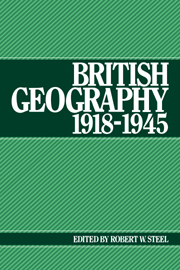Book contents
- Frontmatter
- Contents
- Preface
- 1 The beginning and the end
- 2 Geography during the inter-war years
- 3 Geography in the University of Wales, 1918–1948
- 4 Geography at Birkbeck College, University of London, with particular reference to J. F. Unstead and E. G. R. Taylor
- 5 The Oxford School of Geography
- 6 Geography in the Joint School (London School of Economics and King's College)
- 7 Geography in a University College (Nottingham)
- 8 Geographers and their involvement in planning
- 9 On the writing of historical geography, 1918–1945
- 10 Physical geography in the universities, 1918–1945
- 11 Geographers and geomorphology in Britain between the wars
- 12 British geography, 1918–1945: a personal perspective
- Index
11 - Geographers and geomorphology in Britain between the wars
Published online by Cambridge University Press: 07 October 2009
- Frontmatter
- Contents
- Preface
- 1 The beginning and the end
- 2 Geography during the inter-war years
- 3 Geography in the University of Wales, 1918–1948
- 4 Geography at Birkbeck College, University of London, with particular reference to J. F. Unstead and E. G. R. Taylor
- 5 The Oxford School of Geography
- 6 Geography in the Joint School (London School of Economics and King's College)
- 7 Geography in a University College (Nottingham)
- 8 Geographers and their involvement in planning
- 9 On the writing of historical geography, 1918–1945
- 10 Physical geography in the universities, 1918–1945
- 11 Geographers and geomorphology in Britain between the wars
- 12 British geography, 1918–1945: a personal perspective
- Index
Summary
Alfred Steers has documented the expansion of departments of geography, and of teaching in physical geography within them, before 1945. It is clear from his survey that in research, if not in teaching, ‘physical geography’ meant geomorphology: for while some attention was given to meteorology, climatology, and to some extent pedology and biogeography, it was on the level of elementary service courses for students rather than as a contribution to new knowledge.
What was the intellectual context within which these developments took place? To what extent were the academic achievements of the new physical geography constrained by the slow and scattered nature of its institutional development? What was the attitude of the geologists, throughout the nineteenth century the natural custodians of landform studies, to these activities, and how did the physical geographers respond?
The relationship of geographers with the geologists was a critical one, in various ways and on a variety of levels. When geography first became established at Oxford and Cambridge in the 1880s, geologists were less than enthusiastic: indeed D. W. Freshfield called them ‘the most forward of the would-be “chuckers-out” of geography from the Hall of Education’ (Freshfield 1886: 704). Geology itself was becoming increasingly specialized, and saw much of physical geography as elementary background material with which it was properly concerned, while the study of landforms, scarcely then dignified as a distinct and autonomous field of knowledge, was an indispensable adjunct to their own reconstructions of recent geological history.
- Type
- Chapter
- Information
- British Geography 1918–1945 , pp. 156 - 176Publisher: Cambridge University PressPrint publication year: 1987
- 1
- Cited by



